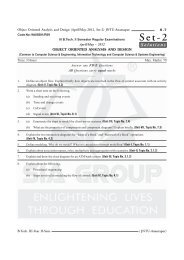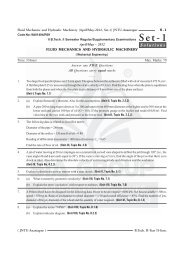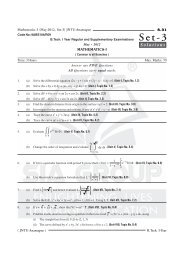Set-1 Final by Mudassir [1-4].p65 - SIA GROUP
Set-1 Final by Mudassir [1-4].p65 - SIA GROUP
Set-1 Final by Mudassir [1-4].p65 - SIA GROUP
Create successful ePaper yourself
Turn your PDF publications into a flip-book with our unique Google optimized e-Paper software.
Generation of Electric Power (April/May-2012, <strong>Set</strong>-1) JNTU-AnantapurCode No: 9A02403/R09II B.Tech. II Semester Regular & Supplementary ExaminationsApril/May - 2012GENERATION OF ELECTRIC POWER( Electrical and Electronics Engineering )S.1Time: 3 Hours Max. Marks: 70Answer any FIVE QuestionsAll Questions carry equal marks- - -1. What are the factors to be considered for the selection of site of a nuclear power station? (Unit-II, Topic No. 2.2)2. Write a short note on types of concentrating collectors. (Unit-III, Topic No. 3.2)3. What are the factors to be considered for selection of the site for a thermal power station? (Unit-I, Topic No. 1.1)4. Discuss the advantages and disadvantages of wind energy. (Unit-IV, Topic No. 4.1)5. Discuss the status of biomass conversion technologies. (Unit-V, Topic No. 5.1)6. Discuss the technology of Ocean Thermal Energy Conversion (OTEC). (Unit-VI, Topic No. 6.2)7. Estimate the generating cost per kWh delivered from a generating station from the following data:Plant capacity = 50 MWAnnual load factor = 40%Capital cost - 1.2 crores; annual cost of wages, taxation etc., = Rs. 4 lakhs; cost of fuel, lubrication, maintenance etc.,= 1.0 paise/kWh generated. Interest 5% per annum, 6% per annum of initial value. (Unit-VII, Topic No. 7.3)8. (a) What are the principal factors involved in fixing of a tariff? (Unit-VIII, Topic No. 8.1)<strong>Set</strong>-1Solutions(b)An industrial consumer has maximum demand of 120 kW and maintains a load factor of 80%. The tariff in forceis Rs. 60 per kVA of maximum demand plus 8 paise per unit. If the average p.f. is 0.8 lagging, calculate the totalenergy consumed per annum and the annual bill. (Unit-VIII, Topic No. 8.3)B.Tech. II-Year II-Sem. ( JNTU-Anantapur )
S.2 Spectrum ALL-IN-ONE Journal for Engineering Students, 2013SOLUTIONS TO APRIL/MAY-2012, SET-1, QPQ1. What are the factors to be considered for theselection of site of a nuclear power station?Answer :April/May-12, <strong>Set</strong>-1, Q1For answer refer Unit-II, Q9.Q2. Write a short note on types of concentratingcollectors.Answer :April/May-12, <strong>Set</strong>-1, Q2For answer refer April/May-11, <strong>Set</strong>-4, Q3(b).Q3. What are the factors to be considered forselection of the site for a thermal powerstation?Answer :April/May-12, <strong>Set</strong>-1, Q3For answer refer Unit-I, Q2.Q4. Discuss the advantages and disadvantagesof wind energy.Answer :April/May-12, <strong>Set</strong>-1, Q4Advantages of Wind Energy1. It is a renewable energy source.2. Supply of fuel and transport is not required.3. Wind power plant consumes less time for itsconstruction and are highly desirable.4. It is a non-polluting power system there<strong>by</strong> no adverseeffect is produced in the environment.5. Wind turbine occupies very small floor area.6. It facilitates remote areas which are not connected toelectricity power grid to use wind turbine forproducing electricity.7. Wind turbines are available in wide range of sizes.8. Ideal choice for rural areas.Disadvantages of Wind Energy1. Power obtained is fluctuating in nature.2. Storage of wind energy is required.3. It does not produce electricity unless there existscontinuous wind from surroundings.4. The system is noisy in operation.5. Only limited amount of power is produced rangingfrom 30 to 300 kW.6. It involves very high initial cost.7. The overall weight of the wind power system isrelatively high.8. Special alloys are to be required in the design of rotorblades which are very costly.Q5. Discuss the status of biomass conversiontechnologies.Answer :April/May-12, <strong>Set</strong>-1, Q5For answer refer Unit-V, Q5.Q6. Discuss the technology of Ocean ThermalEnergy Conversion (OTEC).Answer :April/May-12, <strong>Set</strong>-1, Q6For answer refer Unit-VI, Q13 and Q15.Q7. Estimate the generating cost per kWhdelivered from a generating station from thefollowing data:Plant capacity = 50 MWAnnual load factor = 40%Capital cost - 1.2 crores; annual cost of wages,taxation etc. = ` 4 lakhs cost of fuel,lubrication, maintenance etc. = 1.0 paise/kWh generated. Interest 5% per annum, 6%per annum of initial value.Answer :April/May-12, <strong>Set</strong>-1, Q7Given that,Plant capacity = 50 MWAnnual load factor = 40%= 0.4Capital cost = 1.2 croresAnnual cost of wages, taxation etc = ` 4 lakhsCost of fuel, lubrication, maintenance etc,= 1.0 paise/kWh generated.Interest = 5% per annumDepreciation = 6% per annum of initial valueGenerating cost per kWh delivered = ?We have,Interest and depreciation cost per annum= Capital cost × [ Interest per annum +Depreciation per annum]= 1.2 × 10 7 × (0.05 + 0.06)= 1.2 × 10 7 × 0.11= 13.2 × 10 5= ` 13.2 lakhs ... (1)B.Tech. II-Year II-Sem. ( JNTU-Anantapur )
Generation of Electric Power (April/May-2012, <strong>Set</strong>-1) JNTU-AnantapurS.3Total annual fixed charges= Interest and depreciation cost per annum + Wages and taxation= `13.2 lakh + `4 lakh= `17.2 lakhs= `17.2 × 10 5 ... (2)Units generated per annum = Maximum demand × Load factor × Hours in an yearFor this case, the maximum demand is considered as the plant capacity.∴ Units generated per annum = (50 × 10 3 ) × 0.4 × (24 × 365)= 17.52 × 10 7 kWh ... (3)∴ Total cost of fuel, lubrication etc.= 1 paisa × Units generated per annum= ` (0.01 × 17.52 × 10 7 )= `17.52 × 10 5 ... (4)Total annual charges = Total annual fixed charges + Cost of fuel, lubrication etc.= (17.2 × 10 5 ) + (17.52 × 10 5 )= `34.72 ×10 5 ... (5)Therefore,Generating cost per kWh =TotalannualchargesUnitsgeneratedper annum34.72×10=51752×10= 0.01985≅ 0.02 paise ... (6)In this problem, the equations (1) and (2) represent the fixed charges, whereas the equations (3), (4), (5) and (6)represent the running charges.Q8. (a) What are the principal factors involved in fixing of a tarrif?Answer :For answer refer Unit-VIII, Q1.April/May-12, <strong>Set</strong>-1, Q8(a)(b) An industrial consumer has maximum demand of 120 kW and maintains a load factor of 80%.The tariff in force is Rs. 60 per kVA of maximum demand plus 8 paise per unit. If the averagep.f. is 0.8 lagging, calculate the total energy consumed per annum and the annual bill.Answer :April/May-12, <strong>Set</strong>-1, Q8(b)Given that,Maximum demand = 120 kWLoad factor = 80%Tariff = `60 per kVA of max demand + 8 paise per unitB.Tech. II-Year II-Sem. ( JNTU-Anantapur )
S.4 Spectrum ALL-IN-ONE Journal for Engineering Students, 2013Power factor, cos φ = 0.8 lagTotal energy consumed per annum = ?Annual bill = ?The total energy or unit consumed per annum= Max demand × p.f. × Total hours in an year= 120 × 0.8 × (24 × 365)= 840960 kWhMaximum demand in kVA =1200.8= 150 kVAAnnual bill = Maximum demand charges + Energy charges= `[60 × 150 + 0.08 × 840960]= `76276.8B.Tech. II-Year II-Sem. ( JNTU-Anantapur )


![Set-1 Final by Mudassir [1-4].p65 - SIA GROUP](https://img.yumpu.com/49027305/1/500x640/set-1-final-by-mudassir-1-4p65-sia-group.jpg)
![Set-2 Final by Mudassir [10-22] N.p65 - SIA GROUP](https://img.yumpu.com/50708500/1/184x260/set-2-final-by-mudassir-10-22-np65-sia-group.jpg?quality=85)

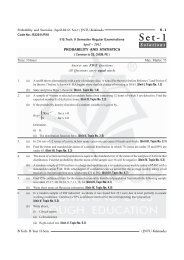
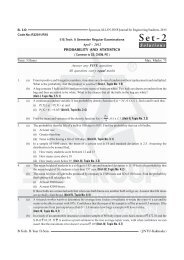
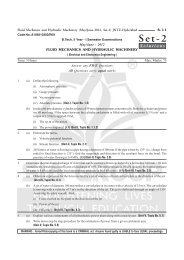

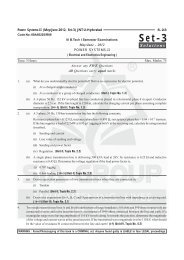
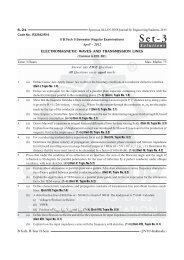
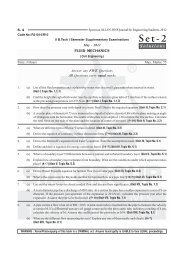
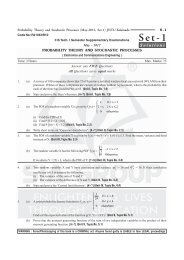
![Set-1 Final by Mudassir [1-16] (M).p65 - SIA GROUP](https://img.yumpu.com/36090047/1/184x260/set-1-final-by-mudassir-1-16-mp65-sia-group.jpg?quality=85)
